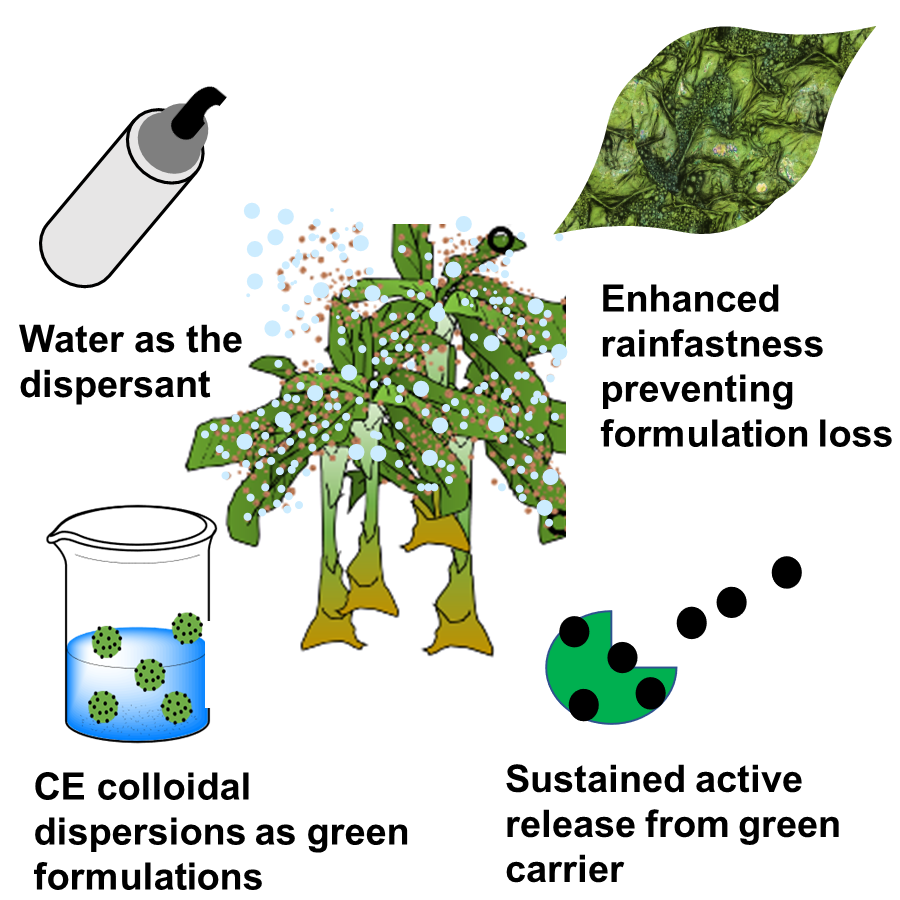Increased awareness of the long-term impacts of agrochemicals has resulted in the hunt for efficient and sustainable delivery platforms. In order to meet the food demands of an exponentially increasing global population, there is a dire need to establish sustainable technologies for targeted delivery of agrochemicals with minimal environmental footprints. We present an adaptable and bio-friendly controlled release platform consisting of aqueous colloidal dispersions of biodegradable cellulose derivatives synthesized through a simple yet scalable anti-solvent precipitation process (Advanced Functional Materials, 2022,
https://doi.org/10.1002/adfm.202108046). We propose utilization of these dispersions as foliar formulations for controlled release of agricultural active ingredients (AI) corroborating their performance through a rigorous diverse spectrum of tests. The biodegradable nature of our polymer particles and use of water as the dispersant medium justify sustainable nature of these formulations. In addition, the adaptability of the dispersions to cater to a range of crops and AI is exhibited through modulation of particle morphology and the particle-AI binding strength.
The colloidal dispersions are synthesized through solvent evaporation process from a ternary mixture of cellulose ester (CE)/water/acetone. Fundamental insights in the phase behavior of the ternary system are analyzed via the Flory Huggins model wherein clear demarcation is observed in particle morphology and phase behavior through varying the ester linkages in the cellulose esters. Change in particle size and shape further effects the binding affinities with the model AI as is corroborated through Isothermal Titration Calorimetry (ITC) analysis and release assays. Our results demonstrate that tuning the particle morphology permits both weak and strong binding with the AI thus allowing achieving both slow and fast AI release as required. Contact angle and surface tension measurements of the dispersions on various model leaf surfaces revealed significantly lower values than water on the surface indicating enhanced wetting. Furthermore, we have verified the functional performance of the colloidal dispersions through simulated rain tests to validate rainfastness and anti-fungal assays to corroborate AI bioavailability. These results are further complimented with stability analysis, and surface interactions with model leaf surfaces.
The potential impact of rainfastness and controlled release formulations can be significant especially in tropical rainy climates where rain induced wash-off necessitates multiple sprays to achieve desired crop yields. This, in turn, increases operational costs in addition to causing environmental pollution, increased pathogen resistance and non-target exposure. CE dispersions as agrochemical formulations can be significant in reducing number of sprays required while maintaining the desired efficacy level. Our study goes the complete wheel starting from a fundamental thermodynamic system analysis of the CE particle formation process and the CE-AI binding interactions to demonstrating the superior rainfastness of the dispersions and the bio-availability of the loaded AI. With their functional performance verified through release and fungal assays, fundamental thermodynamic insights into the dispersion synthesis process and the particle-AI interactions open a window of opportunity allowing tuning particle size and the binding strength of the desired AI. This can allow tailoring of the dispersions to cater to a wide variety of AI, and crops. This âlab to leafâ approach demonstrates the potential of CE dispersions to achieve targeted AI delivering allowing higher efficacy at lower delivery rates.


